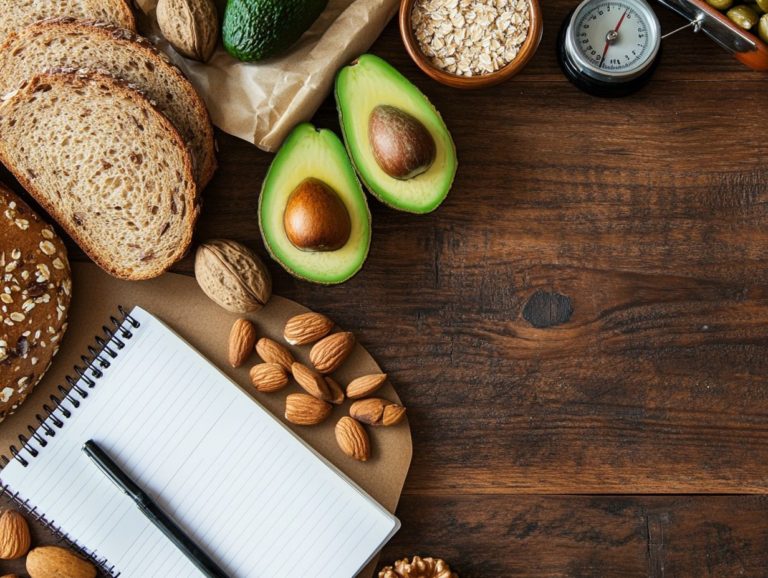10 Ingredients to Always Have for Meal Planning
Meal planning can elevate your cooking experience. It simplifies preparing healthy and tasty meals throughout the week.
This guide reveals ten essential ingredients to stock in your pantry. You’ll find staple grains, protein sources, and fresh fruits and vegetables.
Whether you’re starting your cooking journey or are a seasoned chef, you’ll discover tips for using these ingredients effectively.
Explore how meal planning saves time, cuts costs, and meets your dietary needs!
Contents
- Key Takeaways:
- 1. Staple Grains and Carbohydrates
- 2. Protein Sources
- 3. Fresh Fruits and Vegetables
- 4. Canned or Frozen Vegetables and Fruits
- 5. Healthy Fats and Oils
- 6. Flavor Enhancers
- 7. Condiments and Sauces
- 8. Spices and Herbs
- 9. Broths and Stocks
- 10. Nuts and Seeds
- What Are the Benefits of Meal Planning?
- Frequently Asked Questions
- What are the 10 ingredients you should always have for meal planning?
- Why is it important to have these specific ingredients for meal planning?
- Can I substitute any of these 10 ingredients for other options?
- How can I use these 10 ingredients to create meals for the whole week?
- Do I need to buy all of these 10 ingredients every week for meal planning?
- How can I save money when buying these 10 ingredients for meal planning?
Key Takeaways:
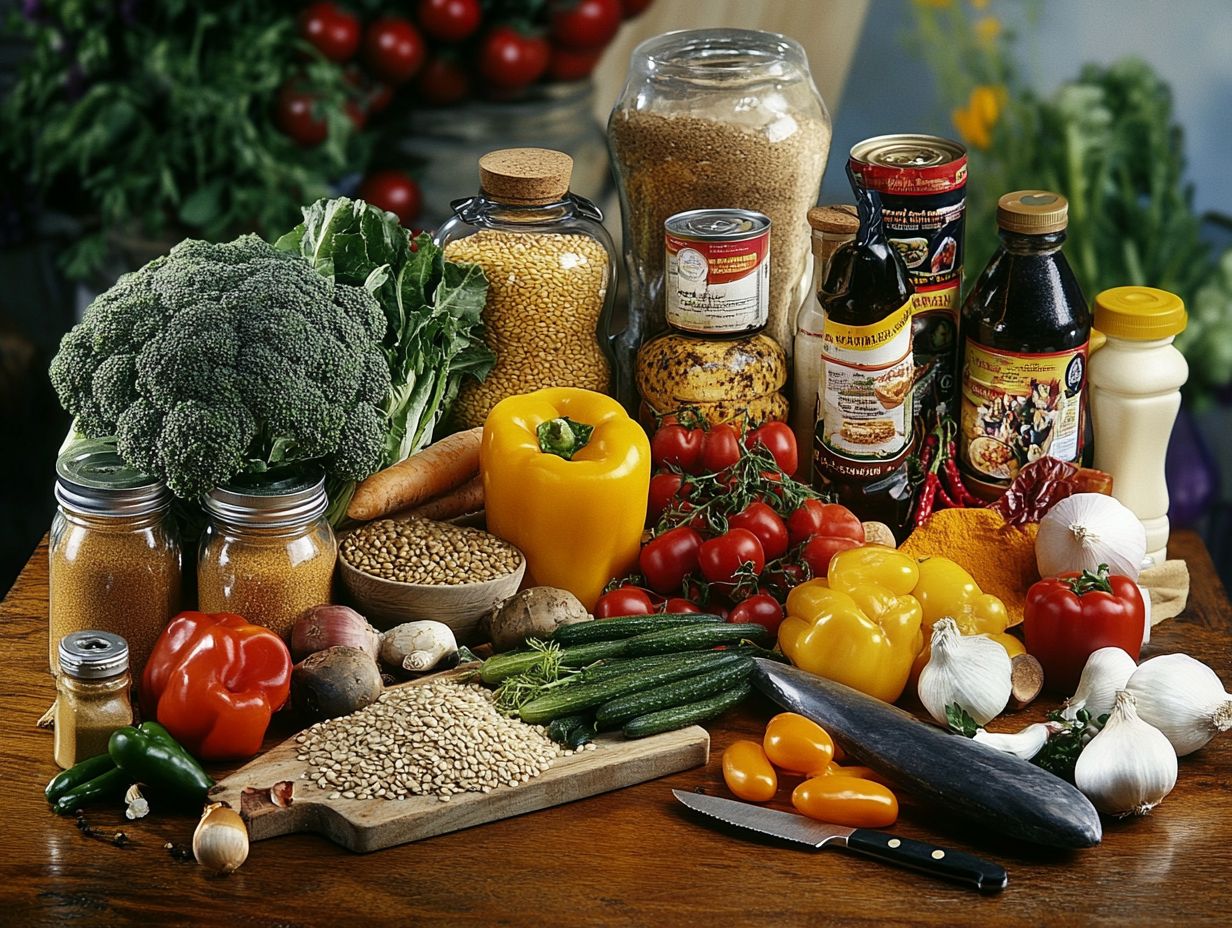
- Always keep staple grains and carbohydrates for easy meal prep and added nutrition.
- Protein sources are crucial for balanced meals and fit into various dishes effortlessly.
- Fresh fruits and vegetables offer vital vitamins and minerals; include them for a healthy diet.
1. Staple Grains and Carbohydrates
Staple grains and carbohydrates are essential for quick, healthy meals. They provide the energy and nutrients needed to power through your day.
Keeping your kitchen stocked with these ingredients sets you up for hassle-free meals when hunger strikes. Options like whole-grain pasta, brown rice, and whole grain bread ensure you get complex carbohydrates and dietary fiber.
These grains are incredibly versatile. Whole-grain pasta pairs beautifully with fresh vegetables and lean proteins in stir-fries or homemade sauces.
Brown rice makes an excellent base for hearty grain bowls topped with grilled meats or roasted veggies. Whole grain bread is not just nutritious for sandwiches; it transforms into delicious toast with avocado or nut butter for a quick breakfast.
Stocking these staples opens the door to tasty meal adventures, ensuring balanced and satisfying meals any day of the week.
2. Protein Sources
Reliable protein sources like dry beans, canned vegetables, and frozen meats help craft quick meals. These ingredients ensure you never compromise on nutrition.
For example, black beans are protein-rich and loaded with fiber, making them perfect for salads and soups. Canned chickpeas shine as a creamy hummus base or in Mediterranean salads, boosting flavor and nutrition.
Frozen chicken is a powerhouse too. Grilling or baking it with spices turns it into a protein-rich dinner.
Incorporating these foods into your meal planning promotes convenience and health in your busy life.
3. Fresh Fruits and Vegetables
Fresh fruits and vegetables are crucial for a healthy diet, packed with vital vitamins and minerals. They shine in quick meals that burst with flavor while keeping added sugars in check.
Incorporating a variety of colors into your meals enhances visual appeal and ensures a range of nutrients. Imagine tossing vibrant red bell peppers with deep green kale in a lively stir-fry.
Seasonal treasures like juicy summer peaches or autumn squash can easily transform into refreshing salads or hearty soups. Focus on colorful fruits and vegetables to unleash creativity in the kitchen and promote overall wellness.
4. Canned or Frozen Vegetables and Fruits
Canned and frozen vegetables and fruits are your go-to options for a well-stocked kitchen. They allow you to effortlessly whip up quick, healthy meals no matter the season. These choices burst with nutrition and flavor, ensuring your dishes remain delicious.
Choosing these options provides a longer shelf life, helping minimize waste while requiring no extensive preparation ideal for busy weeknights. Want dinner ready in under 30 minutes? Picture a quick stir-fry made with frozen bell peppers and broccoli, tossed with pre-cooked chicken or tofu, all drizzled with your favorite sauce. You can have a hearty meal in no time!
And let s not forget about canned tomatoes, perfect for crafting a rich pasta sauce or a comforting chili. They add flavor without the hassle. With these ingredients on hand, you can enjoy wholesome and satisfying meals anytime. Stock up on these ingredients to unlock endless meal possibilities!
5. Healthy Fats and Oils
Healthy fats and oils are essential for balanced meals. By opting for ingredients like healthy cooking oils, nuts, and nut butters, you can turn quick, healthy meals into gourmet experiences.
These ingredients burst with flavor and deliver essential nutrients that support your health. For instance, avocados and olive oil provide an excellent source of monounsaturated fats which promote heart health. Drizzle them on salads or over roasted vegetables for a taste boost. You can easily integrate omega-3 fatty acids found in fatty fish like salmon or walnuts into your daily meals.
Consider a hearty salad topped with grilled salmon or a wholesome breakfast of oatmeal enriched with almond butter and chia seeds. Embrace these choices in your cooking to heighten taste and significantly boost your nutrition.
6. Flavor Enhancers
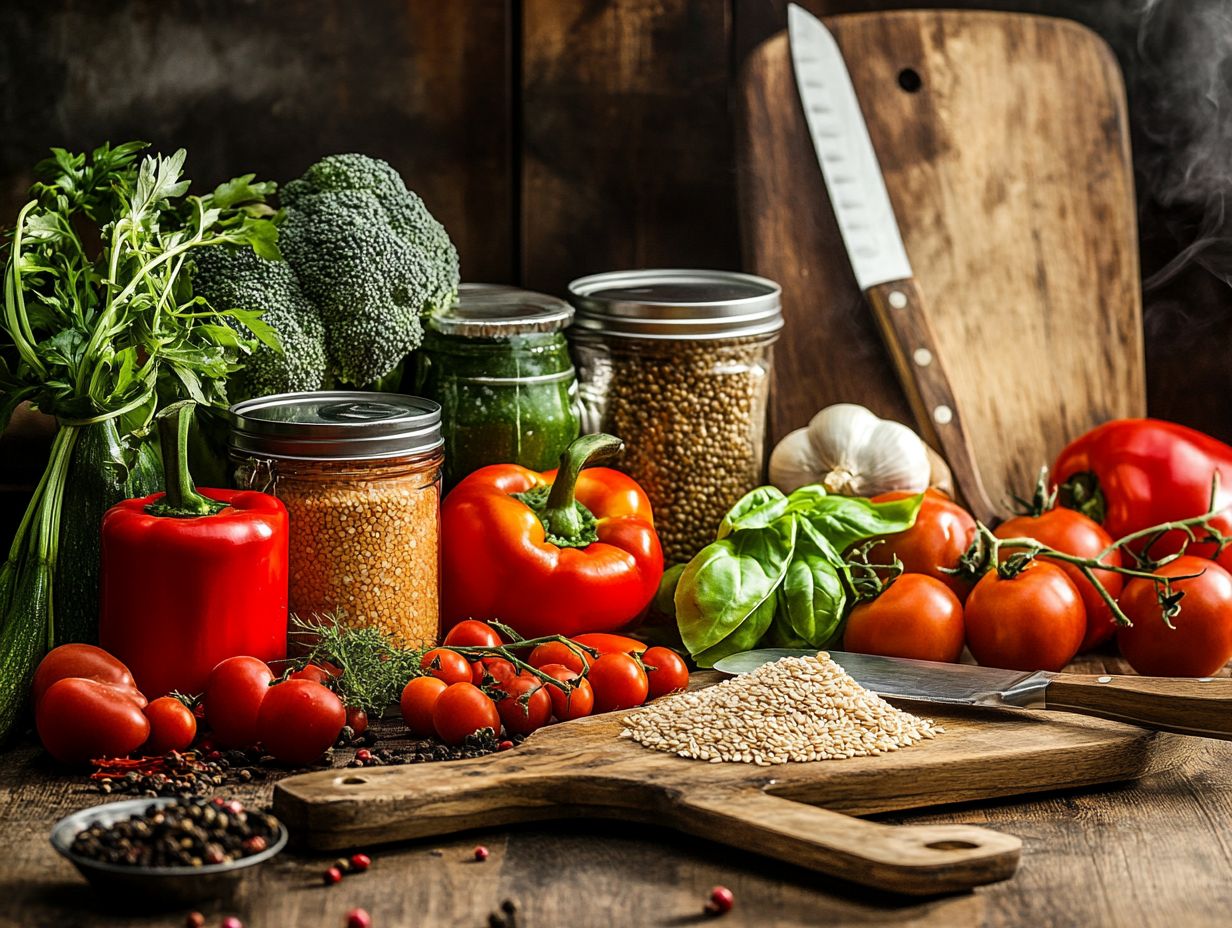
Flavor enhancers like balsamic vinegar, low-sodium soy sauce, and sauces such as spaghetti or marinara can elevate your quick, healthy meals. They transform meals into experiences that are both nutritious and utterly delightful.
By thoughtfully incorporating these ingredients, you can turn simple dishes into culinary masterpieces without sacrificing health. For example, a splash of balsamic vinegar introduces rich sweetness to roasted vegetables, making them utterly irresistible. Meanwhile, low-sodium soy sauce adds depth of umami to stir-fried greens and lean proteins, taking your meals to the next level.
Imagine tossing whole-grain pasta with homemade marinara infused with garlic, fresh herbs, and a hint of red pepper flakes; it s a wholesome yet flavorful dinner that satisfies both palate and conscience. Exploring these combinations enhances taste while ensuring your meals remain balanced and nourishing.
7. Condiments and Sauces
Using condiments and sauces effectively can be your secret weapon for transforming quick, healthy meals into flavor-packed culinary experiences. Even the simplest ingredients come alive when you incorporate options like low-sodium broth and marinara sauce.
By adding a variety of herbs, vinegars, and mustards, you can elevate the taste profile of ordinary dishes without loading up on excess calories or fats. Just a splash of balsamic vinegar infuses grilled vegetables or salads with a rich tang, while a dollop of whole grain mustard serves as a zesty dressing for lean proteins.
Similarly, fresh salsas made with tomatoes and herbs add a vibrant kick, turning a plain chicken breast into a delightful treat while keeping your meal balanced and healthy.
8. Spices and Herbs
Spices and herbs are your secret weapons for crafting quick, healthy meals. They can transform ordinary dishes into culinary masterpieces, ensuring your meals are not only nutritious but also a joy to savor.
Imagine the warming embrace of cinnamon, which can help regulate blood sugar levels. Or consider the invigorating kick of ginger, celebrated for its anti-inflammatory properties. These spices can elevate both flavor and health benefits in your creations.
Basil and oregano bring aromatic richness to Italian cuisine. They also deliver antioxidants that support your overall well-being. Don t overlook turmeric, often praised for its inflammation-fighting potential; when paired with black pepper, it can significantly enhance absorption.
By experimenting with these ingredients and combining them thoughtfully, you can create harmonious flavor profiles. These profiles will entice your palate and offer the myriad health benefits these natural wonders provide.
9. Broths and Stocks
Broths and stocks, especially the low-sodium varieties, are essential in your kitchen. They help craft quick, healthy meals that burst with flavor and nutrition.
Explore a variety of options: vegetable, chicken, beef, and fish broths. Each brings its own unique flair to your culinary creations. For instance, vegetable broth offers a light, earthy profile, while chicken broth adds a comforting depth that can elevate any dish.
Incorporating these bases enhances flavor and contributes essential nutrients like vitamins and minerals to your meals. For a wholesome experience, why not whip up a hearty minestrone soup using vegetable broth? Or enjoy a classic chicken noodle soup with chicken broth, creating a warm and inviting atmosphere.
If you re in the mood for something more refined, try using fish stock to elevate your seafood risotto. This enriches the grains and results in a delightful and nutritious option that s sure to impress.
10. Nuts and Seeds
Nuts and seeds are not just fantastic sources of protein; they also bring a delightful crunch and flavor to your quick, healthy meals. Nut butters offer a creamy touch that elevates smoothies and baked goods to a whole new level.
These tiny powerhouses are packed with essential fats, vitamins, and minerals. They also provide a wealth of antioxidants, compounds that help protect your body from damage. Take walnuts, for instance; they re rich in omega-3 fatty acids, known for their anti-inflammatory properties.
Meanwhile, pumpkin seeds shine with their high magnesium content, a crucial mineral for muscle function and energy production. Incorporating these nutritious delights into your daily meals is effortless.
Try sprinkling chia seeds on your yogurt for an instant boost! Or toss mixed nuts into a hearty salad. If you re looking to unleash your creativity in the kitchen, consider whipping up a batch of chocolate almond energy balls or crafting a savory pesto from sunflower seeds. Both options showcase the delightful versatility of these ingredients.
What Are the Benefits of Meal Planning?
Meal planning offers a wealth of benefits, giving you the power to whip up quick, healthy meals. This practice alleviates the stress of last-minute cooking.
By dedicating just a little time each week to outline your meals, you ll love how easy it is to mix in a variety of ingredients. This significantly enhances your nutrition. For example, prepping a week’s worth of vibrant salads reduces food waste and ensures you get a variety of essential vitamins and minerals for a well-rounded diet.
Employing strategies like batch cooking grains or roasting a large batch of vegetables can effortlessly streamline your weekday dinners. This makes the process both enjoyable and efficient.
Ultimately, effective meal planning fosters a sustainable habit that bolsters your health. It also invites creativity into your kitchen endeavors. Don t miss out on the chance to elevate your meals!
How Can These Ingredients Be Used in Meal Planning?
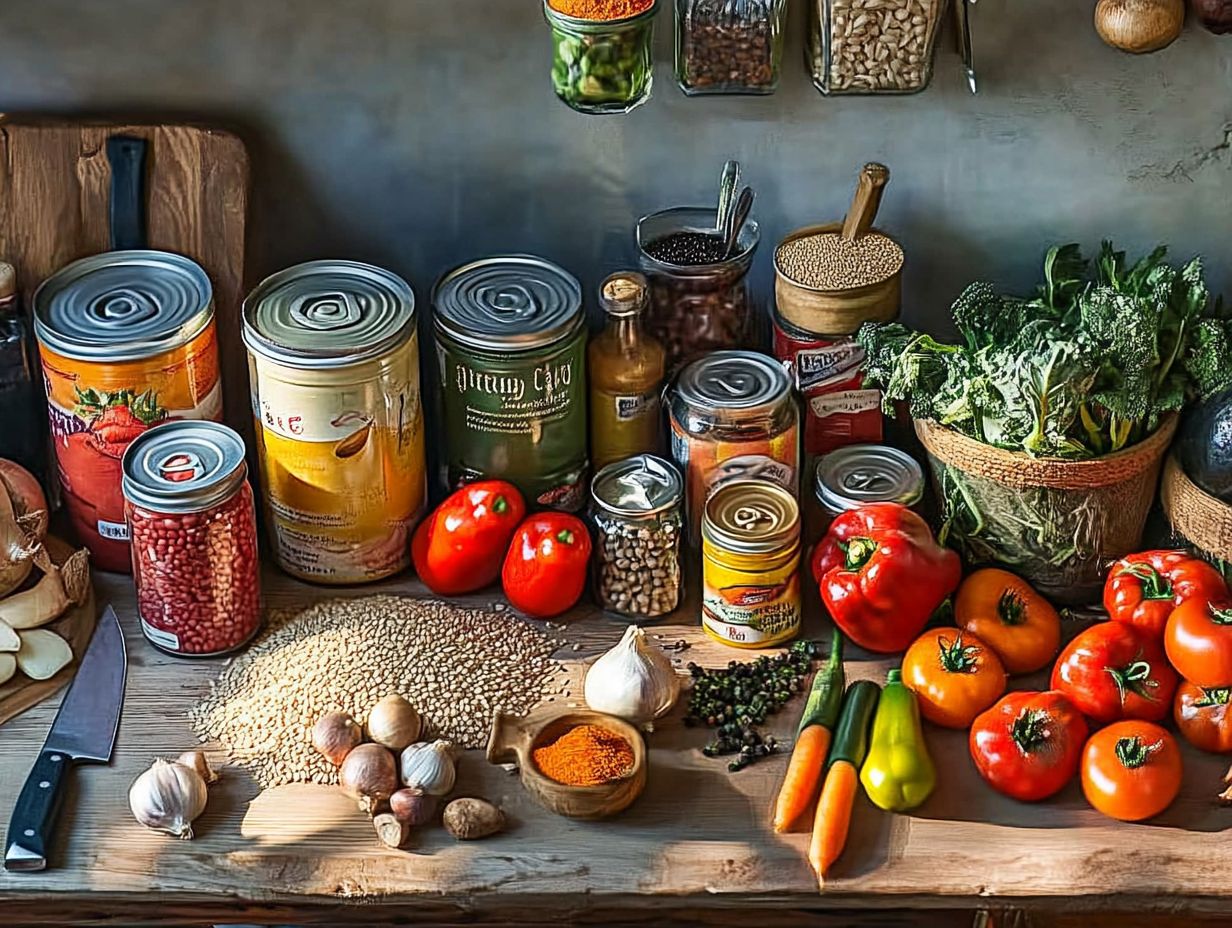
The ingredients discussed can be effortlessly woven into your meal planning. This allows for a delightful array of quick, healthy meals that cater to diverse tastes and dietary requirements while ensuring a seamless cooking experience.
By incorporating lean proteins, vibrant vegetables, and whole grains, you can craft a variety of meal combinations throughout the week. For instance, imagine a simple Tuesday dinner featuring grilled chicken paired with quinoa and roasted broccoli. This blend makes meals tasty and satisfying.
On the other hand, a Friday night stir-fry could make use of leftover veggies tossed with tofu and brown rice for a satisfying way to wrap up the week.
Consider planning themed days like Meatless Monday or Taco Thursday to streamline your grocery shopping. This approach helps maintain nutritional balance and variety. Staying motivated on your healthy eating journey becomes easier with these themes.
What Are Some Meal Planning Tips for Beginners?
Effective meal planning can begin with straightforward tips that lead to quick, healthy meals. This makes the process not only easier but also more enjoyable while ensuring you include a variety of nutrients.
Establishing a basic shopping list can significantly streamline your grocery experience. Focus on incorporating staple ingredients like grains, legumes, seasonal vegetables, and lean proteins. These versatile bases can serve as the foundation for countless dishes.
By planning your meals around these staples, you can effortlessly create a week s worth of nutritious options without feeling overwhelmed. Batch cooking saves you time and reduces food waste.
Preparing larger quantities of meals and storing them in portioned containers simplifies those busy weeknight dinners. This ensures that healthy choices are always on hand, making your journey toward better eating habits achievable and enjoyable.
How Can Meal Planning Save Time and Money?
Meal planning is your secret weapon for saving time and money! By maximizing the potential of your well-stocked kitchen, you can significantly reduce food waste and curb unnecessary purchases.
When you organize your meals in advance, you can take advantage of bulk buying. This often leads to impressive cost savings on groceries. This practice also minimizes those impulsive trips to the store that tend to spiral into unplanned expenses.
A well-structured meal plan makes grocery shopping a breeze, providing you with a clear list of what you actually need. This not only saves you valuable time in the long run but also enhances your efficiency in the kitchen.
Plus, it encourages healthier eating habits, as meals are prepared with intention and care.
What Are Some Healthy Meal Ideas Using These Ingredients?
With the right ingredients at your fingertips, you can whip up a delightful array of healthy meal ideas. These meals are not only quick and easy but also bursting with flavor and nutrition, exemplifying the beauty of a well-stocked kitchen.
Imagine crafting vibrant salads that blend fresh greens with a medley of colorful vegetables. Or think of hearty grain bowls adorned with your choice of protein the possibilities are endless!
Visualize a zesty quinoa salad, drizzled with a tangy vinaigrette and perhaps paired with grilled chicken or chickpeas for that much-needed protein boost. Alternatively, consider a stir-fry brimming with seasonal veggies, saut ed to perfection in a light sauce.
This dish is ready to grace your table in mere minutes an ideal weeknight dinner. Even a simple wrap filled with roasted vegetables and hummus can transform into a delightful lunch option.
These inventive meal ideas not only showcase the delicious ingredients at your disposal but also ensure that healthy eating remains effortlessly enjoyable. Start your meal planning journey today!
How Can Meal Planning Help with Dietary Restrictions or Preferences?
Meal planning can be a game changer for anyone with dietary restrictions or preferences. It allows you to make meal choices that fit your needs while keeping a variety of quick, healthy options within reach.
By carefully considering the available alternatives, you can create balanced menus that not only meet your dietary requirements but also tantalize your taste buds. For example, when catering to vegetarians, think about incorporating hearty legumes like lentils and chickpeas as protein sources. If you re looking for a vegan plan, tofu and tempeh a fermented soy product make fantastic substitutes.
For those who require gluten-free options, a world of grains like quinoa and rice awaits, ensuring your flavorful dishes remain delightful. You can easily create low-sodium meals using the right herbs and spices, enhancing flavors without relying on salt.
With these thoughtful modifications, meal planning transforms into an inclusive venture that celebrates both health and enjoyment.
Watch this video to learn more about meal planning!
Frequently Asked Questions
What are the 10 ingredients you should always have for meal planning?
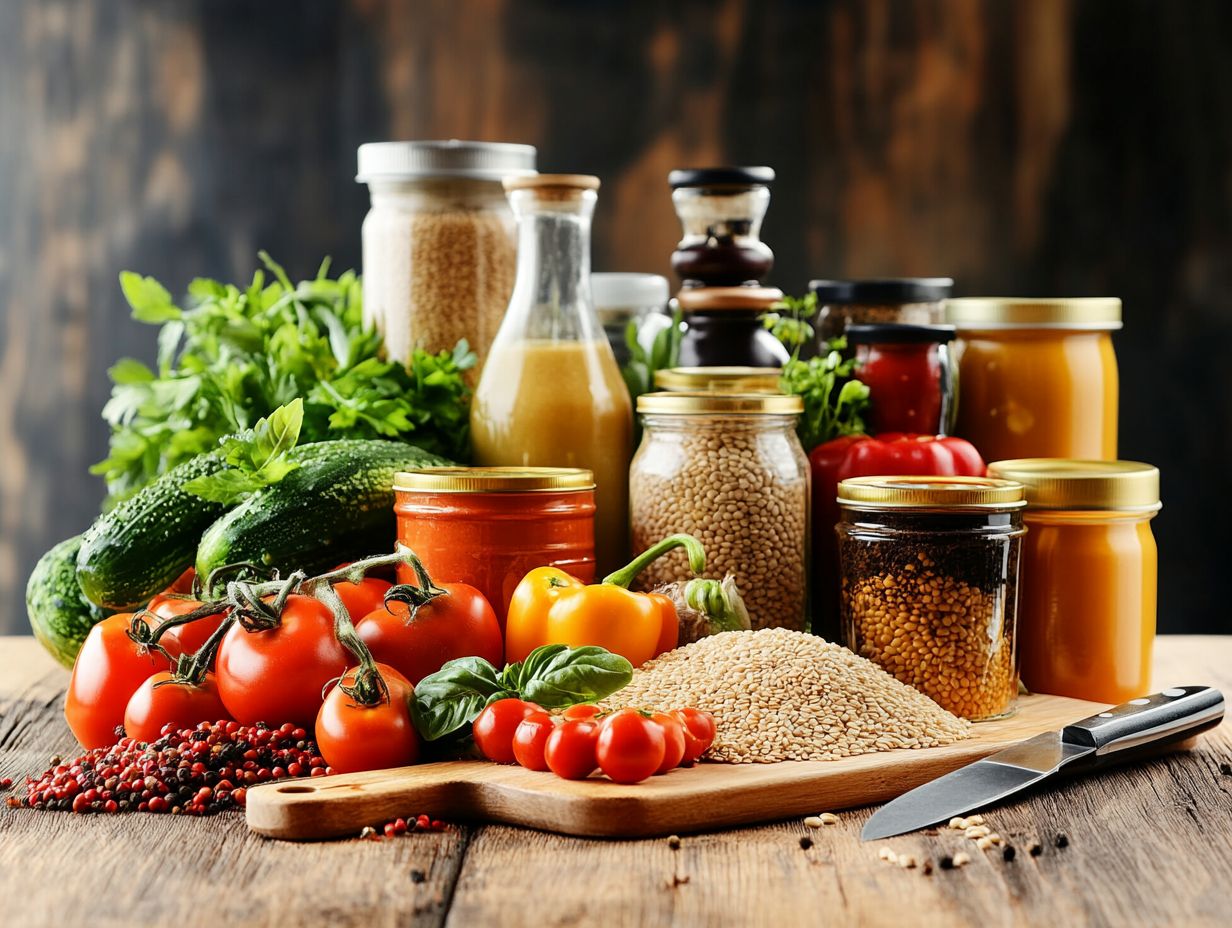
The 10 ingredients you should always have for meal planning are:
- Protein sources (such as chicken, tofu, or beans)
- Grains (like rice or quinoa)
- Vegetables (fresh or frozen)
- Fruits (fresh or canned)
- Herbs and spices
- Healthy fats (like olive oil or avocado)
- Broth or stock
- Canned tomatoes
- Eggs
- A variety of condiments (such as soy sauce, mustard, or hot sauce)
Why is it important to have these specific ingredients for meal planning?
These ingredients provide a good balance of nutrition, flavor, and versatility for meal planning. Protein, grains, and vegetables are the building blocks of a healthy meal, while herbs and spices add flavor without extra calories. Healthy fats are essential for our bodies, and canned tomatoes and broth provide a base for many recipes. Incorporating the 5 best practices for healthy meal planning can further enhance your meals. Eggs are a great source of protein and can be used in various dishes, while condiments add a finishing touch to meals.
Can I substitute any of these 10 ingredients for other options?
Absolutely! These ingredients are just suggestions. You can substitute them based on your dietary preferences or availability. For example, if you don’t eat meat, you can swap chicken for tofu or beans. If you’re allergic to eggs, consider using flaxseed or chia seeds as substitutes. The key is having a variety of ingredients that you enjoy and can use in different ways.
How can I use these 10 ingredients to create meals for the whole week?
With these 10 ingredients, you can create a variety of meals for the week. For example, use chicken, rice, and vegetables to make a stir-fry, or combine beans, canned tomatoes, and spices to make a hearty chili. You can also mix and match these ingredients to create different dishes, such as a rice and bean bowl with avocado and hot sauce or a vegetable omelette. To enhance your meal prep, consider utilizing 5 essential tools for successful meal planning. The possibilities are endless!
Do I need to buy all of these 10 ingredients every week for meal planning?
No, you don’t need to buy all of these ingredients every week. The idea is to maintain a well-stocked pantry, fridge, and freezer with these items, so you can use them whenever you need to plan a meal. Some ingredients, like dried herbs or canned tomatoes, have a longer shelf life, allowing you to buy them in bulk and use them throughout the month.
How can I save money when buying these 10 ingredients for meal planning?
To save money, consider buying these ingredients in bulk, especially when they are on sale. Opt for frozen vegetables or canned fruits, which are usually more affordable than fresh produce. Additionally, plan your meals according to what’s on sale or in season. Don t forget to check for coupons or discounts at your local grocery store or farmer’s market.
Start planning your meals today to enjoy healthier eating habits!


